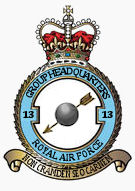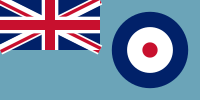No. 13 Group RAF facts for kids
Quick facts for kids No. 13 Group RAF |
|
|---|---|

Group badge
|
|
| Active | 1 April 1918–18 October 1919 15 March 1939–20 May 1946 4 April 1955–31 December 1961 |
| Country | United Kingdom |
| Branch | Royal Air Force |
| Type | Group Headquarters |
| Role | Defence of the Scotland, Northern Ireland and Northern England |
| Part of | RAF Fighter Command |
| Garrison/HQ | Newcastle, England (1939–1943) Inverness, Scotland (1943–1945) Dalcross, Scotland (1945–1946) |
| Motto(s) | Non crambem/Da vrambon sed carnem (Latin for 'Not cabbage but meat') |
| Royal Air Force Ensign |  |
No. 13 Group was a special part of the Royal Air Force (RAF) that existed at different times in the 20th century. It was like a big team responsible for protecting the skies. This group is most famous for its crucial role in defending the northern parts of the United Kingdom during the Battle of Britain in World War II.
Contents
Early Years: First World War
No. 13 Group RAF was first created on 1 April 1918. This was during the final year of the First World War. It was initially part of a larger area called No. 3 Area. Soon after, it moved to the Midland Area. However, its first time as a group didn't last long. On 18 October 1919, it was combined with No. 3 Group and stopped existing on its own.
Defending the Skies: Second World War
No. 13 Group was brought back to life just before World War II began. The RAF realized they needed a new group to manage the air defenses. This new group would protect Scotland, Northern Ireland, and the northern parts of England. It was officially reformed in September 1939. During the early days of the war, Air Vice Marshal Richard Saul was in charge of No. 13 Group.
The Dowding System: How Air Defence Worked
No. 13 Group, like other RAF fighter groups, used a clever system called the Dowding system. This system helped control fighter planes. It made sure they could quickly find and attack enemy aircraft. The main headquarters for 13 Group was near Newcastle upon Tyne. A special "Filter Room" nearby helped process all the information.
The group had several key airfields, which were like home bases for their fighter planes:
- RAF Acklington
- RAF Dyce
- RAF Inverness
- RAF Turnhouse
- RAF Usworth
- RAF Wick
The Battle of Britain: Protecting the North
During the intense Battle of Britain, No. 13 Group had a very important job. While other groups fought fiercely in the south, 13 Group guarded the north. They also helped out the busy 11 Group by sending them extra planes and pilots. Sometimes, squadrons that had been fighting hard would come to the quieter bases in the north to rest and get ready for more action.
No. 13 Group also helped pilots learn more. They created a special booklet called "Forget-Me-Nots for Fighters." This guide shared important tips for fighter pilots.
The German air force, called the Luftwaffe, made a big mistake during the Battle of Britain. They thought No. 13 Group had very few fighter planes. They believed that any attacks on Scotland would be easy. But they were wrong! When German bombers tried to attack northern England and Scotland, they were met by many British fighters. German fighter planes like the Messerschmitt Bf 109 couldn't fly far enough to protect their bombers all the way to Scotland. This meant the bombers were often left unprotected. No. 13 Group's Spitfire and Hurricane squadrons were ready for them.
On 15 August 1940, the Germans tried a big daylight attack on northern England. They sent many bombers and fighters. But No. 13 Group fought back hard. Out of 115 bombers and 35 fighters, 16 bombers and 7 fighters were shot down. It was a big loss for the Luftwaffe.
After the Battle of Britain
After the Battle of Britain, No. 13 Group continued its important work. Its squadrons helped RAF Coastal Command patrol the seas for German submarines, called U-boats. They also provided air cover to protect convoys of ships. New pilots often started their careers with a 13 Group squadron. This allowed them to gain experience with less risk of being shot down.
In 1943, No. 14 Group was combined into No. 13 Group. This meant No. 13 Group became even bigger. Its headquarters also moved from Newcastle in England to Inverness in Scotland.
Post-War Years and Final Disbandment
In November 1945, after the war ended, the headquarters moved again to RAF Dalcross in Scotland. At this time, the group was responsible for five squadrons at two airfields. No. 13 Group was officially disbanded on 20 May 1946.
However, it was reformed nine years later, on 4 April 1955. It was based at RAF Watnall and again focused on fighter operations. No. 13 Group finally stopped existing on 31 December 1961. At that point, it was renamed and became part of No. 11 Group.
See also

